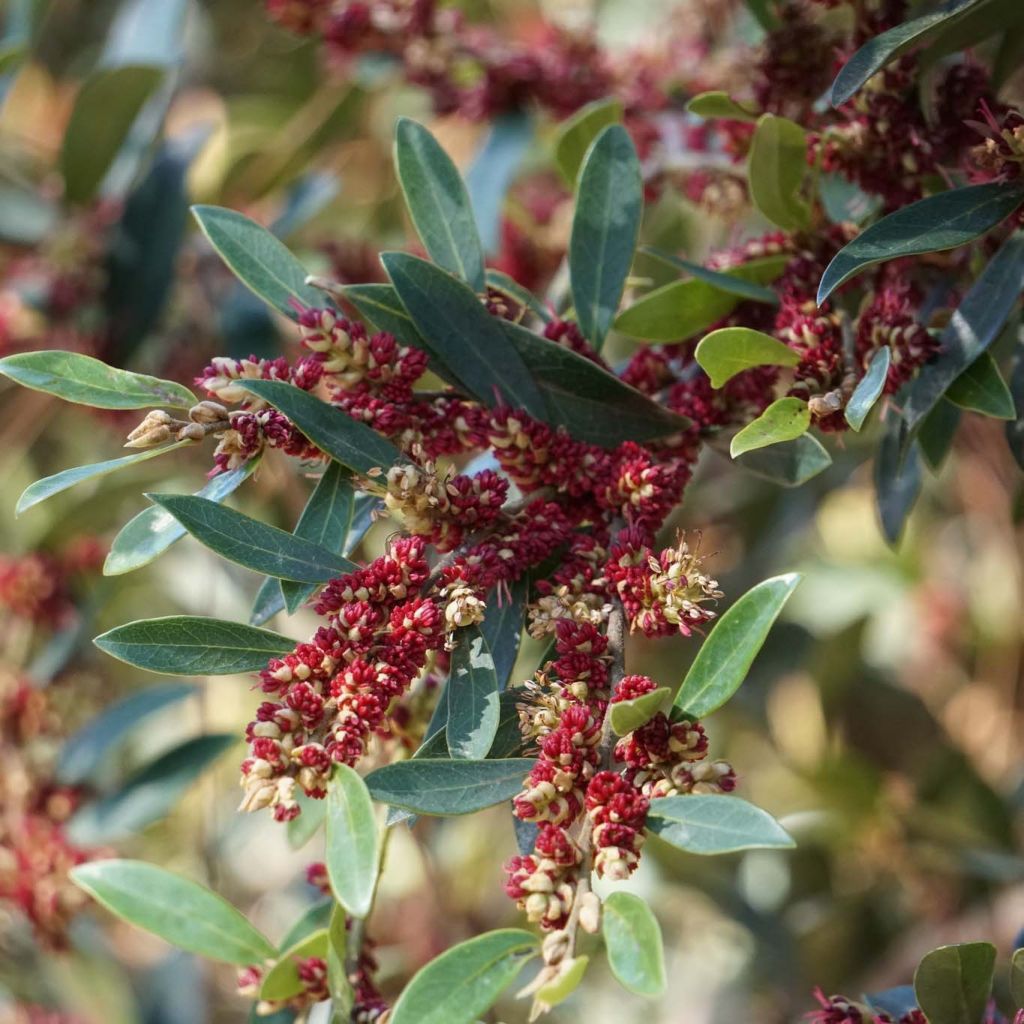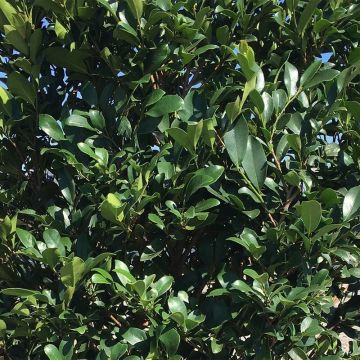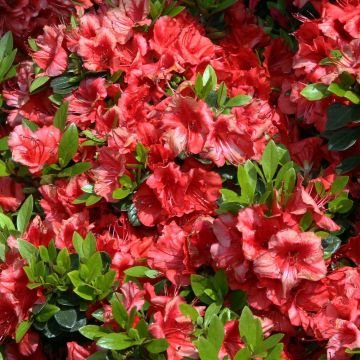

Distylium myricoides (x) racemosus Vintage Jade


Distylium myricoides (x) racemosus Vintage Jade
Distylium myricoides (x) racemosus Vintage Jade
Distylium myricoides x racemosus Vintage Jade
Distylium hybride
This item cannot be shipped to the selected country
Delivery charge from €5.90
Delivery charge from €5.90
Delivery charge from €5.90
More information
Schedule delivery date,
and select date in basket
This plant carries a 24 months recovery warranty
More information
We guarantee the quality of our plants for a full growing cycle, and will replace at our expense any plant that fails to recover under normal climatic and planting conditions.
From €5.90 for pickup delivery and €6.90 for home delivery
Express home delivery from €8.90.
From €5.90 for pickup delivery and €6.90 for home delivery
Express home delivery from €8.90.
From €5.90 for pickup delivery and €6.90 for home delivery
Express home delivery from €8.90.
Does this plant fit my garden?
Set up your Plantfit profile →
Description
The Distylium 'Vintage Jade' is a low spreading bush, highly ornamental with its graceful silhouette that extends in cascades of evergreen leaves in a brilliant blue-green colour. Its winter flowering with slender petals, similar to the flowers of its cousin the Witch Hazel, attracts attention with its warm reddish-brown colour. Still relatively unknown, it is nevertheless an interesting alternative to boxwoods, cherry laurels, hollies and other more traditional evergreen shrubs used to structure the garden throughout the seasons. Indeed, distylium is resistant to diseases and insects, tolerates both sun and partial shade, and can thrive in well-drained soils, from dry to moist, without limestone. Hardy down to -15°C, it prefers north-facing sun and partial shade in hot climates.
Distylium (x) 'Vintage Jade' is a horticultural hybrid obtained by cross-breeding between Distylium myricoides and Distylium racemosus, two species native to eastern and southeastern Asia belonging to the family Hamamelidaceae. It blooms in late winter or early spring (March-April), offering axillary clusters of small petal-less flowers composed of reddish-brown stamens. This distylium forms a bush reaching about 80 cm (31.5 in) wide and 1 m (3 ft 4 in) tall, a little wider, with a fairly slow growth. Its arched, spreading, and layered branches give it a unique cascading habit. Its evergreen foliage consists of small, tough, entire, alternate, obovate to lanceolate leaves, of a dark glossy blue-green colour. They resemble laurel leaves in shape but are disease-free.
Distylium 'Vintage Jade', an accent and structural plant similar to dwarf conifers, will find its place in a small hedge, along a border, as well as in a shrub or perennial bed. Interesting for its blue-green foliage in winter, it can be associated with forsythias, Japanese quinces, or Japanese kerrias that will harmonize well with its colourful young shoots and its flowering throughout spring. It fits well in Japanese gardens, as well as in shrub beds in dry areas, as it tolerates water scarcity in deep soil. Nandina, Choisya, laurustinus, and Myrtus Tarentina can accompany it, for example, in a small evergreen hedge. It also grows very well in pots and its branches can be used in floral arrangements.
Boxwoods have been experiencing some difficulties for the past decade, as a disease causes their decline and spreads rapidly from one plant to another, leaving them dry. Distylium is an excellent alternative that is not susceptible to this extremely destructive fungus.
Report an error about the product description
Distylium myricoides (x) racemosus Vintage Jade in pictures




Plant habit
Flowering
Foliage
Botanical data
Distylium
myricoides x racemosus
Vintage Jade
Hamamelidaceae
Distylium hybride
Cultivar or hybrid
Other Distylium
Planting and care
The 'Vintage Jade' Distylium is a low-maintenance bush that is easy to grow in most of our climates. It thrives in the sun in cool climates or partial shade further south, in a deep soil without excessive limestone, moist to dry but well-drained, and rather fertile. Limestone can cause its foliage to yellow in the presence of high levels, especially in heavy soils. If this occurs, treat it with iron chelate. This bush can tolerate temperatures as low as -15°C (5 °F), so it is best to plant it in a sheltered location in very cold climates. In spring, apply fertilizer. Pruning is not necessary. If desired, after flowering, lightly prune it by 10 cm (3.9 in) and remove branches that compromise its attractive habit.
Planting period
Intended location
Care
This item has not been reviewed yet - be the first to leave a review about it.
Shrubs for pots
Haven't found what you were looking for?
Hardiness is the lowest winter temperature a plant can endure without suffering serious damage or even dying. However, hardiness is affected by location (a sheltered area, such as a patio), protection (winter cover) and soil type (hardiness is improved by well-drained soil).

Photo Sharing Terms & Conditions
In order to encourage gardeners to interact and share their experiences, Promesse de fleurs offers various media enabling content to be uploaded onto its Site - in particular via the ‘Photo sharing’ module.
The User agrees to refrain from:
- Posting any content that is illegal, prejudicial, insulting, racist, inciteful to hatred, revisionist, contrary to public decency, that infringes on privacy or on the privacy rights of third parties, in particular the publicity rights of persons and goods, intellectual property rights, or the right to privacy.
- Submitting content on behalf of a third party;
- Impersonate the identity of a third party and/or publish any personal information about a third party;
In general, the User undertakes to refrain from any unethical behaviour.
All Content (in particular text, comments, files, images, photos, videos, creative works, etc.), which may be subject to property or intellectual property rights, image or other private rights, shall remain the property of the User, subject to the limited rights granted by the terms of the licence granted by Promesse de fleurs as stated below. Users are at liberty to publish or not to publish such Content on the Site, notably via the ‘Photo Sharing’ facility, and accept that this Content shall be made public and freely accessible, notably on the Internet.
Users further acknowledge, undertake to have ,and guarantee that they hold all necessary rights and permissions to publish such material on the Site, in particular with regard to the legislation in force pertaining to any privacy, property, intellectual property, image, or contractual rights, or rights of any other nature. By publishing such Content on the Site, Users acknowledge accepting full liability as publishers of the Content within the meaning of the law, and grant Promesse de fleurs, free of charge, an inclusive, worldwide licence for the said Content for the entire duration of its publication, including all reproduction, representation, up/downloading, displaying, performing, transmission, and storage rights.
Users also grant permission for their name to be linked to the Content and accept that this link may not always be made available.
By engaging in posting material, Users consent to their Content becoming automatically accessible on the Internet, in particular on other sites and/or blogs and/or web pages of the Promesse de fleurs site, including in particular social pages and the Promesse de fleurs catalogue.
Users may secure the removal of entrusted content free of charge by issuing a simple request via our contact form.
The flowering period indicated on our website applies to countries and regions located in USDA zone 8 (France, the United Kingdom, Ireland, the Netherlands, etc.)
It will vary according to where you live:
- In zones 9 to 10 (Italy, Spain, Greece, etc.), flowering will occur about 2 to 4 weeks earlier.
- In zones 6 to 7 (Germany, Poland, Slovenia, and lower mountainous regions), flowering will be delayed by 2 to 3 weeks.
- In zone 5 (Central Europe, Scandinavia), blooming will be delayed by 3 to 5 weeks.
In temperate climates, pruning of spring-flowering shrubs (forsythia, spireas, etc.) should be done just after flowering.
Pruning of summer-flowering shrubs (Indian Lilac, Perovskia, etc.) can be done in winter or spring.
In cold regions as well as with frost-sensitive plants, avoid pruning too early when severe frosts may still occur.
The planting period indicated on our website applies to countries and regions located in USDA zone 8 (France, United Kingdom, Ireland, Netherlands).
It will vary according to where you live:
- In Mediterranean zones (Marseille, Madrid, Milan, etc.), autumn and winter are the best planting periods.
- In continental zones (Strasbourg, Munich, Vienna, etc.), delay planting by 2 to 3 weeks in spring and bring it forward by 2 to 4 weeks in autumn.
- In mountainous regions (the Alps, Pyrenees, Carpathians, etc.), it is best to plant in late spring (May-June) or late summer (August-September).
The harvesting period indicated on our website applies to countries and regions in USDA zone 8 (France, England, Ireland, the Netherlands).
In colder areas (Scandinavia, Poland, Austria...) fruit and vegetable harvests are likely to be delayed by 3-4 weeks.
In warmer areas (Italy, Spain, Greece, etc.), harvesting will probably take place earlier, depending on weather conditions.
The sowing periods indicated on our website apply to countries and regions within USDA Zone 8 (France, UK, Ireland, Netherlands).
In colder areas (Scandinavia, Poland, Austria...), delay any outdoor sowing by 3-4 weeks, or sow under glass.
In warmer climes (Italy, Spain, Greece, etc.), bring outdoor sowing forward by a few weeks.

















































